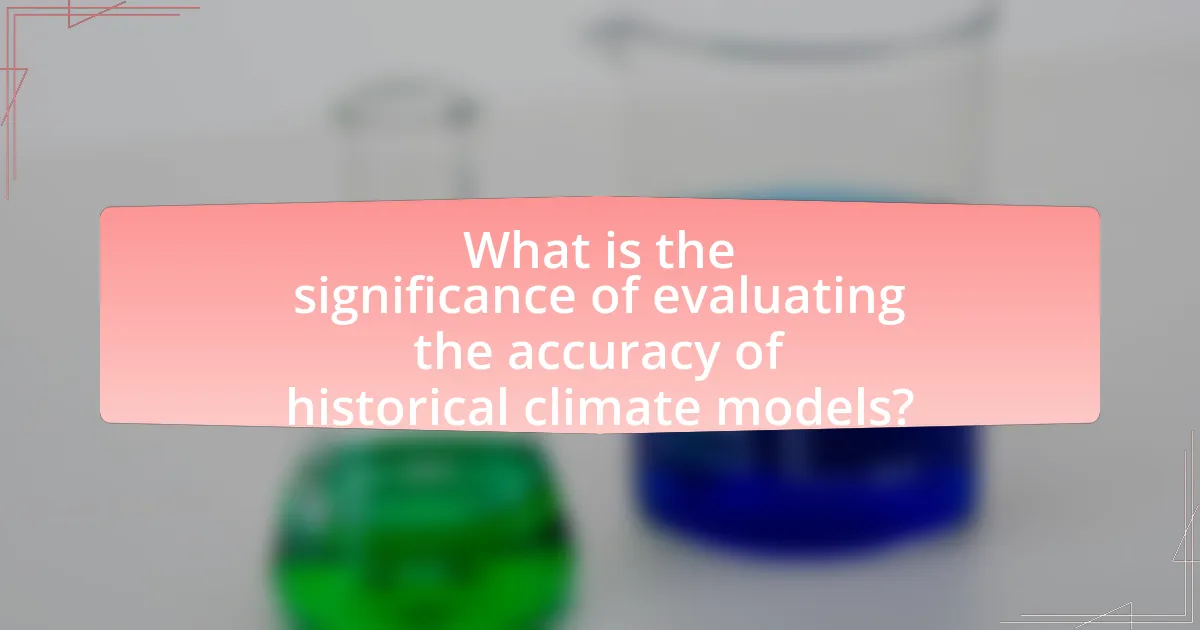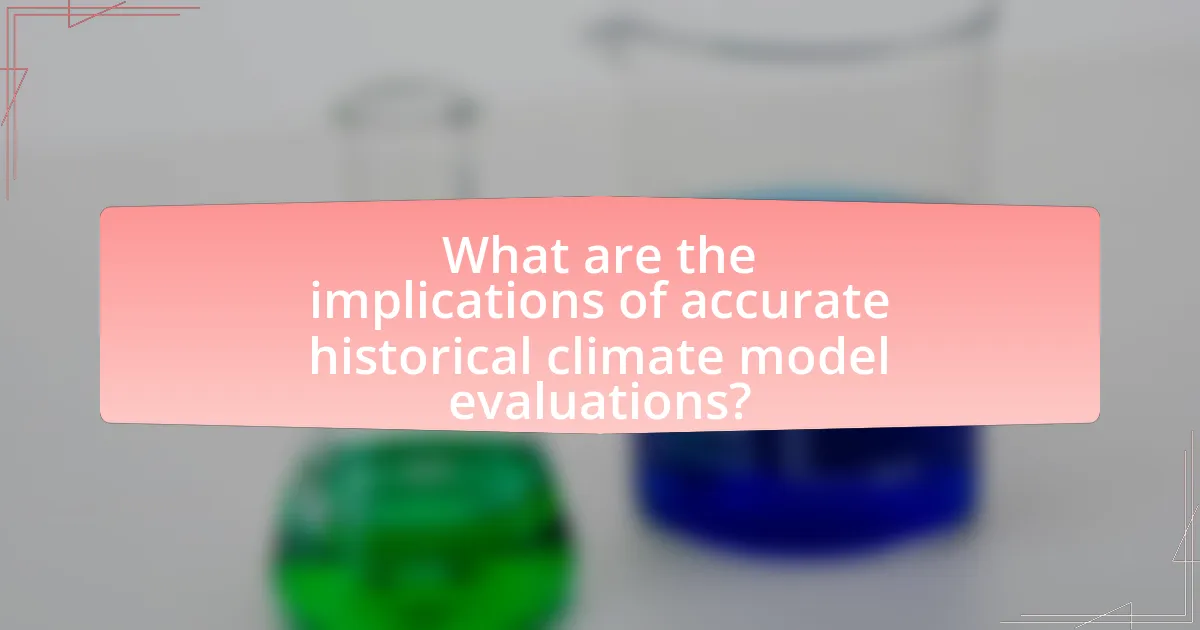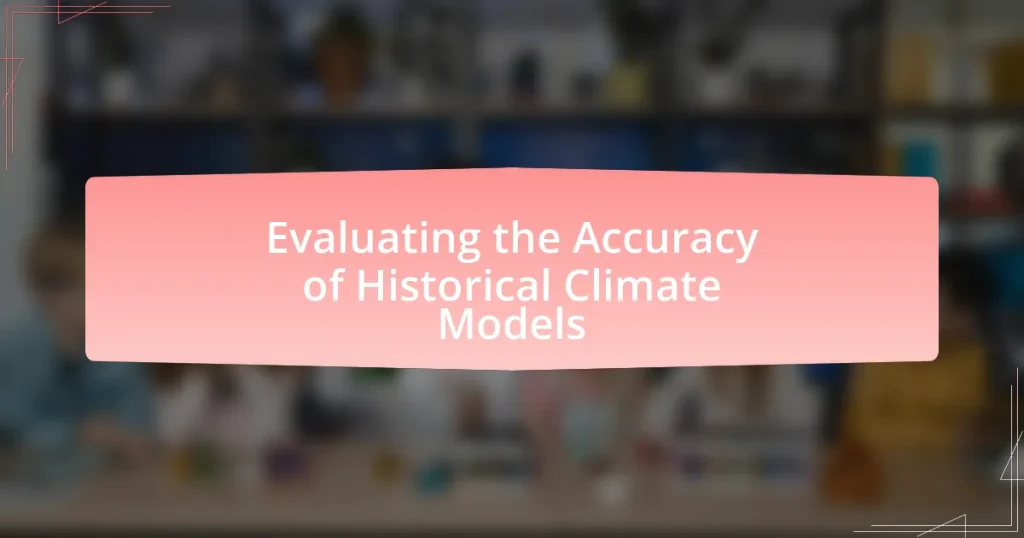Evaluating the accuracy of historical climate models is crucial for understanding their reliability in predicting future climate scenarios. This article examines the significance of assessing these models, highlighting their role in informing policy decisions and improving predictive capabilities. It discusses the methodologies used for evaluation, including comparisons with observed data and statistical techniques, while addressing challenges such as data limitations and uncertainties. The implications of accurate evaluations on future climate predictions and public perception of climate science are also explored, emphasizing best practices and the importance of interdisciplinary approaches in enhancing model assessments.

What is the significance of evaluating the accuracy of historical climate models?
Evaluating the accuracy of historical climate models is significant because it informs the reliability of future climate predictions. Accurate historical models provide a benchmark for assessing how well current models simulate climate dynamics, which is crucial for understanding potential climate change impacts. For instance, the Intergovernmental Panel on Climate Change (IPCC) reports indicate that models which accurately replicated past temperature trends are more likely to produce reliable future projections. This evaluation process helps scientists refine models, improve predictive capabilities, and guide policy decisions based on credible climate forecasts.
Why is it important to assess historical climate models?
Assessing historical climate models is crucial for understanding their accuracy and reliability in predicting future climate scenarios. By evaluating these models, researchers can identify discrepancies between predicted and observed climate data, which helps refine modeling techniques and improve future projections. For instance, the Intergovernmental Panel on Climate Change (IPCC) reports highlight that historical model assessments have revealed significant insights into climate sensitivity and feedback mechanisms, thereby enhancing our understanding of climate dynamics. This process is essential for informing policy decisions and developing effective climate adaptation strategies.
What role do historical climate models play in understanding climate change?
Historical climate models are essential for understanding climate change as they provide a framework for simulating past climate conditions and assessing the impacts of various factors on climate systems. These models utilize historical data, such as temperature records and greenhouse gas concentrations, to recreate climate scenarios, allowing scientists to analyze trends and variability over time. For instance, the Coupled Model Intercomparison Project (CMIP) has generated multiple historical simulations that help validate current climate projections by comparing them against observed climate data. This validation process is crucial for improving the accuracy of future climate predictions and understanding the potential consequences of ongoing climate change.
How do historical climate models influence policy and decision-making?
Historical climate models significantly influence policy and decision-making by providing data-driven projections that inform governmental and organizational strategies. These models, which simulate past climate conditions and trends, help policymakers understand potential future scenarios, enabling them to assess risks and develop mitigation and adaptation strategies. For instance, the Intergovernmental Panel on Climate Change (IPCC) reports utilize historical climate data to project future climate impacts, guiding international agreements like the Paris Agreement. Such models have been instrumental in shaping legislation aimed at reducing greenhouse gas emissions, as evidenced by the implementation of carbon pricing mechanisms in various countries based on model predictions of climate change impacts.
What challenges are faced in evaluating historical climate models?
Evaluating historical climate models faces several challenges, primarily due to data limitations, model complexity, and uncertainty in climate processes. Data limitations arise from the sparse and uneven distribution of historical climate observations, which can lead to inaccuracies in model validation. Model complexity presents difficulties as many climate models incorporate numerous variables and interactions, making it hard to isolate specific factors affecting climate predictions. Additionally, uncertainty in climate processes, such as feedback mechanisms and natural variability, complicates the assessment of model performance. These challenges hinder the ability to accurately evaluate and compare historical climate models, impacting their reliability for future climate projections.
What are the limitations of data used in historical climate models?
The limitations of data used in historical climate models include gaps in temporal and spatial coverage, inaccuracies in proxy data, and uncertainties in climate forcings. Temporal gaps arise from the uneven distribution of observational data over time, particularly before the 20th century, which can lead to incomplete climate records. Spatial coverage is often limited, especially in remote regions, resulting in less reliable climate projections for those areas. Proxy data, such as tree rings or ice cores, can introduce inaccuracies due to their sensitivity to local conditions and assumptions made during interpretation. Additionally, uncertainties in climate forcings, such as greenhouse gas concentrations and volcanic activity, can affect model accuracy, as these factors are often estimated rather than directly measured. These limitations collectively challenge the reliability of historical climate models in accurately representing past climate conditions.
How do uncertainties in climate data affect model evaluations?
Uncertainties in climate data significantly impact model evaluations by introducing variability that can lead to inaccurate predictions and assessments. When climate models are evaluated against uncertain data, the reliability of the model outputs is compromised, as discrepancies between observed and modeled data can arise from both model limitations and data inaccuracies. For instance, a study published in the journal “Nature” by Knutti and Sedláček (2012) highlights that uncertainties in temperature and precipitation data can lead to divergent climate projections, affecting decision-making processes in climate policy. Thus, the presence of uncertainties necessitates careful consideration in model evaluations to ensure that conclusions drawn are robust and reflective of actual climate dynamics.

How are historical climate models evaluated for accuracy?
Historical climate models are evaluated for accuracy through a combination of comparison with observed climate data and the use of statistical methods. Researchers assess the models by analyzing how well their projections align with actual historical temperature, precipitation, and other climate variables over specific time periods. For instance, the Intergovernmental Panel on Climate Change (IPCC) reports utilize multi-model ensembles to compare model outputs against historical observations, employing metrics such as root mean square error (RMSE) and correlation coefficients to quantify accuracy. This rigorous evaluation process ensures that models can reliably simulate past climate conditions, which is crucial for predicting future climate scenarios.
What methodologies are used to assess the accuracy of climate models?
The methodologies used to assess the accuracy of climate models include validation against historical data, inter-model comparisons, and performance metrics such as root mean square error (RMSE) and correlation coefficients. Validation against historical data involves comparing model outputs with observed climate records to determine how well the model replicates past climate conditions. Inter-model comparisons assess the consistency and variability among different climate models, providing insights into their reliability. Performance metrics quantify the accuracy of model predictions, with RMSE measuring the average deviation between predicted and observed values, while correlation coefficients indicate the strength of the relationship between model outputs and actual observations. These methodologies collectively ensure that climate models are rigorously evaluated for their predictive capabilities.
How do researchers compare model predictions with actual climate data?
Researchers compare model predictions with actual climate data by utilizing statistical methods and validation techniques. They assess the accuracy of climate models by analyzing how well the predicted values align with observed data over specific time periods and geographical locations. For instance, researchers often employ metrics such as root mean square error (RMSE) and correlation coefficients to quantify the differences between model outputs and real-world measurements. Studies, such as those published in the Journal of Climate, demonstrate that these comparisons help identify biases in models and improve their predictive capabilities, thereby enhancing the reliability of climate projections.
What statistical techniques are employed in model evaluation?
Statistical techniques employed in model evaluation include cross-validation, mean squared error (MSE), root mean squared error (RMSE), and R-squared. Cross-validation assesses a model’s predictive performance by partitioning data into subsets, training the model on some subsets while validating it on others. MSE quantifies the average squared difference between predicted and observed values, providing insight into model accuracy. RMSE, the square root of MSE, offers a more interpretable metric by expressing errors in the same units as the original data. R-squared measures the proportion of variance in the dependent variable that can be explained by the independent variables, indicating the model’s explanatory power. These techniques are widely recognized in statistical literature for their effectiveness in evaluating model performance.
What metrics are commonly used to measure model accuracy?
Common metrics used to measure model accuracy include accuracy, precision, recall, F1 score, and mean squared error (MSE). Accuracy quantifies the proportion of correct predictions among total predictions, while precision measures the correctness of positive predictions. Recall assesses the model’s ability to identify all relevant instances, and the F1 score provides a balance between precision and recall. Mean squared error evaluates the average squared difference between predicted and actual values, indicating the model’s predictive performance. These metrics are essential for assessing the effectiveness of historical climate models in accurately representing observed data.
What is the significance of root mean square error in model evaluation?
Root Mean Square Error (RMSE) is significant in model evaluation as it quantifies the difference between predicted and observed values, providing a clear measure of model accuracy. RMSE is particularly useful because it gives higher weight to larger errors, making it sensitive to outliers, which is crucial in climate modeling where extreme values can have substantial impacts. For instance, in evaluating historical climate models, RMSE helps researchers assess how well models replicate observed temperature or precipitation patterns, thereby guiding improvements in model development. Studies have shown that lower RMSE values correlate with better predictive performance, reinforcing its role as a standard metric in model evaluation.
How do correlation coefficients contribute to understanding model performance?
Correlation coefficients quantitatively measure the strength and direction of the relationship between predicted and observed values in model performance. In the context of evaluating historical climate models, a high correlation coefficient indicates that the model’s predictions closely align with actual climate data, suggesting effective performance. For instance, a correlation coefficient close to 1 implies a strong positive relationship, meaning that as one variable increases, the other does as well, which is crucial for validating climate models against historical observations. This statistical measure helps researchers identify how well a model captures the underlying climate dynamics, thereby informing improvements and adjustments to enhance predictive accuracy.

What are the implications of accurate historical climate model evaluations?
Accurate historical climate model evaluations enhance the reliability of climate predictions and inform policy decisions. By validating models against historical data, researchers can identify strengths and weaknesses in climate projections, leading to improved forecasting accuracy. For instance, the Intergovernmental Panel on Climate Change (IPCC) emphasizes that accurate evaluations help in understanding climate sensitivity and regional impacts, which are crucial for effective climate adaptation strategies. Furthermore, accurate evaluations can guide funding and resource allocation for climate research and mitigation efforts, ensuring that investments are directed toward the most effective solutions.
How do accurate evaluations impact future climate predictions?
Accurate evaluations significantly enhance the reliability of future climate predictions by providing a validated framework for model performance. When historical climate models are rigorously assessed, their strengths and weaknesses are identified, allowing for improved calibration and refinement of predictive algorithms. For instance, the Intergovernmental Panel on Climate Change (IPCC) reports that models with high accuracy in simulating past climate conditions tend to produce more reliable projections for future scenarios. This correlation is evidenced by the consistent alignment of model outputs with observed temperature trends over the last century, which reinforces the importance of accurate evaluations in guiding climate policy and adaptation strategies.
What lessons can be learned from past model evaluations for future modeling efforts?
Past model evaluations reveal that transparency in methodology and assumptions significantly enhances the credibility and reproducibility of climate models. For instance, the Intergovernmental Panel on Climate Change (IPCC) reports emphasize the importance of clearly documenting model parameters and validation processes, which allows for better comparison and understanding of model outputs. Additionally, incorporating a diverse range of data sources and scenarios in evaluations has shown to improve model robustness, as evidenced by the successful predictions made by models that utilized comprehensive datasets during the 2000s. Furthermore, iterative feedback from model evaluations has led to refinements in modeling techniques, demonstrating that continuous learning from past evaluations is crucial for improving future modeling efforts.
How does accuracy in historical models affect public perception of climate science?
Accuracy in historical climate models significantly influences public perception of climate science by establishing credibility and trust in scientific findings. When historical models accurately predict climate trends, they reinforce the validity of climate science, leading to greater public acceptance of climate change as a real and pressing issue. For instance, the Intergovernmental Panel on Climate Change (IPCC) reports demonstrate that models which successfully replicated past temperature changes have increased confidence in future climate projections. This correlation between model accuracy and public trust is evident in surveys showing that individuals are more likely to support climate policies when they believe in the reliability of climate models.
What best practices should be followed in evaluating historical climate models?
Best practices for evaluating historical climate models include conducting thorough validation against observed data, ensuring transparency in model assumptions and methodologies, and utilizing multi-model ensembles for comparison. Validation against observed data is crucial as it allows researchers to assess the accuracy of model predictions; for instance, the Coupled Model Intercomparison Project (CMIP) provides a framework for comparing model outputs with historical climate records. Transparency in assumptions and methodologies enhances reproducibility and trust in the models, as seen in the Intergovernmental Panel on Climate Change (IPCC) reports, which detail the processes behind model development. Finally, employing multi-model ensembles helps capture a range of uncertainties and improves the robustness of climate projections, as demonstrated in studies that aggregate results from various models to provide a more comprehensive understanding of climate dynamics.
How can interdisciplinary approaches enhance model evaluation accuracy?
Interdisciplinary approaches enhance model evaluation accuracy by integrating diverse methodologies and perspectives from various fields, such as climate science, statistics, and social sciences. This integration allows for a more comprehensive understanding of complex systems, leading to improved validation techniques and error analysis. For instance, combining statistical methods from mathematics with ecological insights can refine model parameters and assumptions, resulting in more reliable predictions. Research has shown that interdisciplinary collaboration can lead to innovative evaluation frameworks, as evidenced by studies like “The Role of Interdisciplinary Research in Climate Change Adaptation” published in the journal Environmental Science & Policy, which highlights how diverse expertise contributes to more robust climate models.
What role does continuous data collection play in improving model assessments?
Continuous data collection is essential for improving model assessments as it provides real-time insights that enhance the accuracy and reliability of predictions. By consistently gathering data, researchers can identify discrepancies between model outputs and actual observations, allowing for timely adjustments and refinements to the models. For instance, the National Oceanic and Atmospheric Administration (NOAA) utilizes continuous climate data to validate and update their climate models, ensuring they reflect current conditions and trends. This iterative process of data collection and model adjustment leads to more precise assessments of climate phenomena, ultimately improving the overall understanding of historical climate patterns.


